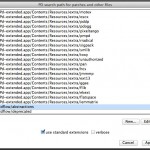import processing.opengl.*;
import javax.media.opengl.*;
import javax.media.opengl.glu.GLU;
import java.util.Random;
import com.nativelibs4java.opencl.*;
import com.nativelibs4java.opencl.CLMem.Usage;
import org.bridj.Pointer;
import static org.bridj.Pointer.*;
final int particlesCount = 200000;
GL2 gl;
PGL pgl;
int [] vbo = new int[1];
CLContext context;
CLQueue queue;
Pointer<Float> velocities;
CLKernel updateParticleKernel;
CLBuffer<Float> massesMem, velocitiesMem;
CLBuffer<Byte> interleavedColorAndPositionsMem;
Pointer<Byte> interleavedColorAndPositionsTemp;
int elementSize = 4*4;
void setup() {
size(800, 600, OPENGL);
background(0);
randomSeed(millis());
PGraphicsOpenGL pg = (PGraphicsOpenGL) g;
pgl = pg.beginPGL();
gl = pgl.gl.getGL().getGL2();
gl.glClearColor(0, 0, 0, 1);
gl.glClear(GL.GL_COLOR_BUFFER_BIT);
gl.glEnable(GL.GL_BLEND);
gl.glEnable(GL2.GL_POINT_SMOOTH);
gl.glPointSize(1f);
initOpenCL();
pg.endPGL();
}
void initOpenCL() {
context = JavaCL.createContextFromCurrentGL();
queue = context.createDefaultQueue();
Pointer<Float> masses = allocateFloats(particlesCount).order(context.getByteOrder());
velocities = allocateFloats(2 * particlesCount).order(context.getByteOrder());
interleavedColorAndPositionsTemp = allocateBytes(elementSize * particlesCount).order(context.getByteOrder());
Pointer<Float> positionsView = interleavedColorAndPositionsTemp.as(Float.class);
for (int i = 0; i < particlesCount; i++) {
masses.set(i, 0.5f + 0.5f * random(1));
velocities.set(i * 2, random(-0.5, 0.5) * 0.2f);
velocities.set(i * 2 + 1, random(-0.5, 0.5) * 0.2f);
int colorOffset = i * elementSize;
int posOffset = i * (elementSize / 4) + 1;
byte r = (byte) 220, g = r, b = r, a = r;
interleavedColorAndPositionsTemp.set(colorOffset++, r);
interleavedColorAndPositionsTemp.set(colorOffset++, g);
interleavedColorAndPositionsTemp.set(colorOffset++, b);
interleavedColorAndPositionsTemp.set(colorOffset, a);
float x = random(-0.5, 0.5) * width/2.0,
y = random(-0.5, 0.5) * height/2.0;
positionsView.set(posOffset, (float) x);
positionsView.set(posOffset + 1, (float) y);
}
velocitiesMem = context.createBuffer(Usage.InputOutput, velocities, false);
massesMem = context.createBuffer(Usage.Input, masses, true);
gl.glGenBuffers(1, vbo, 0);
gl.glBindBuffer(GL.GL_ARRAY_BUFFER, vbo[0]);
gl.glBufferData(GL.GL_ARRAY_BUFFER, (int) interleavedColorAndPositionsTemp.getValidBytes(), interleavedColorAndPositionsTemp.getByteBuffer(), GL2.GL_DYNAMIC_COPY);
gl.glBindBuffer(GL.GL_ARRAY_BUFFER, 0);
interleavedColorAndPositionsMem = context.createBufferFromGLBuffer(Usage.InputOutput, vbo[0]);
String pgmSrc = join(loadStrings(dataPath("ParticlesDemoProgram.cl")), "\n");
CLProgram program = context.createProgram(pgmSrc);
updateParticleKernel = program.build().createKernel("updateParticle");
callKernel();
}
void draw() {
queue.finish();
gl.glClear(GL.GL_COLOR_BUFFER_BIT);
gl.glBlendFunc(GL.GL_SRC_ALPHA, GL.GL_SRC_COLOR);
gl.glMatrixMode(GL2.GL_PROJECTION);
gl.glLoadIdentity();
pgl.glu.gluOrtho2D(-width/2 - 1, width/2 + 1, -height/2 - 1, height/2 + 1);
gl.glMatrixMode(GL2.GL_MODELVIEW);
gl.glBindBuffer(GL2.GL_ARRAY_BUFFER, vbo[0]);
gl.glInterleavedArrays(GL2.GL_C4UB_V2F, elementSize, 0);
gl.glDrawArrays(GL.GL_POINTS, 0, particlesCount);
gl.glBindBuffer(GL2.GL_ARRAY_BUFFER, 0);
callKernel();
}
void callKernel() {
CLEvent kernelCompletion;
synchronized(updateParticleKernel) {
interleavedColorAndPositionsMem.acquireGLObject(queue);
updateParticleKernel.setArgs(massesMem,
velocitiesMem,
interleavedColorAndPositionsMem.as(Float.class),
new float[] {
mouseX-width/2, height/2-mouseY
}
,
new float[] {
width, height
}
,
2.0,
2.0,
0.9,
0.8,
(byte) 0);
int [] globalSizes = new int[] {
particlesCount
};
kernelCompletion = updateParticleKernel.enqueueNDRange(queue, globalSizes);
interleavedColorAndPositionsMem.releaseGLObject(queue);
}
} |







